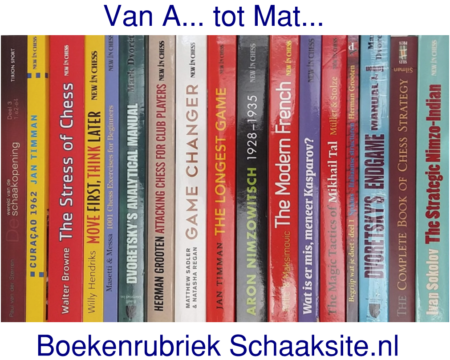Recensie: Davorin Kuljasevic – Beyond Material

Afgelopen donderdag op de clubavond was het weer zo ver. Ik had een pion meer maar mijn tegenstander had me in de houdgreep. Ik kon gaan keepen en dan waarschijnlijk twintig zetten later moegestreden opgeven. Er zat echter ook een zeer speculatief dame-offer in de stelling. Materieel kreeg ik maar een loper en twee pionnen terug, maar daar kwam wel een open stelling bij waarin mijn stukken weer vrij konden gaan dreigen en wie weet combineren. Mijn tegenstander ging al snel de complicaties uit de weg en gaf de dame terug. Het resulterende eindspel leek remise maar ik wist het zelfs nog te winnen.
Is er een beter argument voor een schaakboek dan direct resultaat in je partijen? Ik weet zeker dat als ik Beyondmaterial van Davorin Kuljasevic niet aan het bekijken was voor deze site dat ik het offer niet eens had overwogen (mijn tegenstander werd er ook volkomen door verrast, gaf hij na de partij toe en verspeelde daardoor zijn grote voorsprong op de klok). Sommige boeken geven hele praktische aanwijzingen, anderen laten je op een andere manier naar het schaakspel kijken. Dat laatste doet dit boek en dan ook nog eens op een heel prettig wijze gepresenteerd. Kuljasevic heeft geen enorme ervaring als schrijver, maar zijn stijl is soepel en hij weet zijn boek goed op te bouwen. Je herkent ogenblikkelijk de coach in hem.
Zo kent het boek een strakke opbouw:
I Attachment to material
II Relative value of material
III Time beats material
IV Space beats material
V Psychology of non-materialism
VI Is it good to be greedy in chess?
Elk hoofdstuk is dan na een inleiding weer onderverdeeld in subthema’s. We nemen bijvoorbeeld hoofdstuk twee waar de relatieve waarde van materiaal uiteengerafeld wordt in:
A Misplaced pieces
B Uncoordinated pieces
C Limited mobility and lag in development
D Preponderance of pieces in local operations
E Superior harmony of pieces
Als lezer weet je daardoor altijd waar je aan toe bent en kun je (heel handig voor een clubschaker met een fulltimebaan) de stof in hapklare stukjes tot je nemen. Elk hoofdstuk wordt vervolgens afgesloten met oefeningen die oplopen in moeilijkheidsgraad (tien per hoofdstuk). Hier een voorbeeld uit hoofdstuk vier (pagina 199):
De antwoorden staan keurig achter in het boek waarbij het enige minpuntje is dat de uitleg soms wat summier is.
Ik zou deze recensie kunnen vullen met vele leerzame voorbeelden, maar ik beperk me tot een van mijn lievelingsonderwerpen: psychologie in het schaakspel. Hoe benader je een tegenstander die dol is op offeren en aanvallen. Rashid Nezhmetdinov geeft een koekje van eigen deeg aan niemand minder dan Mikhail Tal (Moskou 1959 ronde 7, pagina 218-220):
Black is doing well. He has a strong centralized knight and a bishop pair that covers many important squares. If he could get time to castle, his chances in the endgame would be better due to the d-pawn. It seems like White cannot do much in this endgame, but Nezhmetdinov finds a way.
19. f5!?
A very direct move. Objectively speaking, this is a bluff, but if we have learned anything from the games in this chapter, it is that the psychological value of a move can sometimes (more than) compensate for its lack of objective value. Nezhmetdinov obviously wanted to use his development advantage at any cost, but he probably also wanted to put Tal under pressure for two reasons. The first one is that he had beaten him once before and bad memories do not help when you have to defend. Secondly, as a markedly attacking and initiative-minded player, Tal was not used to defending. Nezhmetdinov was obviously not interested in playing out a ‘boring’ endgame that would ensue after 19. Pc5 Lc5 20.Tc5 0-0 21.Ta5 Ld3=.
19…. Lg7
Tal plays it safe. He had already lost a game where Nezhmetdinov had attacked him before, so his caution is understandable. He was probably expecting to castle once his opponent moved his knight from d4, when his bishop pair would become very powerful. But it was not to be…There was absolutely nothing wrong with taking the pawn 19…gf5 20. Pf5,Ld3 and after 21. Ped6,Ld6 22. Pd6,Ke7 Black would connect his rooks with excellent winning chances in the long run. But Tal was too focused on getting his king to safety against a dangerous opponent.
20. f6!
Nezhmetdinov’s feeling for the dynamic potential of his pieces is impressive. This brave pawn sacrifices itself so that the rest of his army can break in and create chaos in Black’s position. No less importantly, Black gets no time to castle.
20…. Pxf6 (…) 21. Pd6+ Ke7 22. Pxf7!
Nezhmetdinov is giving Tal a taste of his own medicine! This piece sacrifice is not fully correct, but it will pose Black difficult practical problems to solve because of his poor development and piece coordination.
22…. Kxf7 23. Tc7+ Kg8 24. Pxe6 Pe8 25. Td7
This is the critical moment for Black. He is up a piece, but his rook on h8 is completely out of play and White’s activity is quite serious. A calm head and concrete calculation are necessary in such situations. However, for reasons that we can only guess at, Tal makes a terrible blunder.
25…. Lf6??
This allows Nehzmetdinov to demonstrate his combinative genius. Black had several reasonable alternatives instead:
(…) C) However, a move with the h-pawn: 25…h5! (or h6) would address his greatest problem – the immobile rook on h8. Now, 26.Pg7,Pg7 27.Tee7 would be met with 27…,Th7!, when Black would be threatening to trade a pair of rooks with 28…,Te8, etc. While this seems not too difficult in analysis, in a real game, it is far from obvious; otherwise Tal would have found it. My guess is that Tal did not like the look of the two white rooks on the seventh rank, so he played 25…Lf6 to take the e7- and d8-squares under control. However, he failed to consider the following move.
26. Tf1!
Brilliant! Black has no good defence against the mating threats, and he has to give up a piece.
26…. Pg7
The point is that after 26…,Lc8, White has a study-like double rook sacrifice: 27.Tf6! with two possible mating finales: 27…,Pf6 28.Tg7# and 27…,Ld7 28.Tf8#!
Dit voorbeeld laat goed de werkwijze van Kuljasevic zien. Hij gebruikt veel tekst zonder te zeer af te doen aan de harde analyse. Daarbij biedt hij vooral inzicht in denkprocessen en laat eerdere thema’s (hier: poor development and piece coordination uit hoofdstuk twee) helder terugkomen. Beyond material is een rijk boek maar het behoeft wel enige schaakkennis en -ervaring. Het boek is daarmee te uitdagend voor de matige clubschaker.
Na lezing van dit boek voelde ik me een betere schaker. Niet omdat ik een openingsvariant nu wel beheerste of allerlei handige tips me eigen had gemaakt, maar omdat ik breder kon kijken naar het schaakspel. Natuurlijk was het stom toeval dat dit meteen zijn vruchten afwierp in een clubpartij, maar aan de andere kant bewijst dit wel meteen de praktische waarde van dit boek.
Koop dit boek als je beter wil gaan schaken door je handelingsrepertoire te vergroten met een goed onderbouwde anti-materialistische houding.
Koop dit boek niet als je rating structureel onder de 1800 zit want dan is dit boek te moeilijk.

Boek: Beyond material: Ignore the face value of your pieces and discover the importance of time, space and psychology in chess
Auteur: Davorin Kuljasevic
Uitgeverij: New in Chess
ISBN-nummer: 9789056918606
Pagina’s: 336
Gepubliceerd: 2019
Link naar website uitgever: https://www.newinchess.com/beyond-material
Link naar onze recensenten.
———————————————————————————-
Antwoord op de opgave:
Veselin Topalov – Hikaru Nakamura (St Louis 2015 2nd round)
16. e5 (16.ef5?!,Lf5 17.dc6,bc6 looks really nice for Black) Pd5 (16…,cd5 17.Pd6,Ld6 18.ed6,Dd6 19.b3 is an even worse version for Black) 17.ed6,Ld6 18.Pd6,Dd6 19.b3! for the sacrificed pawn, White obtains a strong positional pressure along the a1-h8 diagonal, which is surprisingly difficult to deal with.

